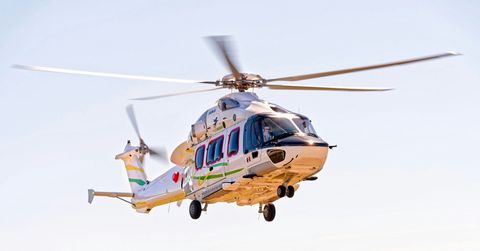CityAirbus NextGen leaves no milestone unturned

CityAirbus NextGen’s imminent power-on is the latest in a year of exciting developments. Here's an update on the electric vertical takeoff and landing (eVTOL) prototype with Balkiz Sarihan, Head of Urban Air Mobility at Airbus.
“Someone asked me what we’re focusing on this year, and I said, ‘we’re going to build, build, build.’ This is what we’ve done,” says Balkiz Sarihan, smiling. At Airbus Helicopters’ Donauwörth facilities, the CityAirbus NextGen was being assembled as she spoke. “Anytime we arrive on site, you want to run and see what else is new.”
Watching it take shape, with subcomponents arriving daily, is what the team has been working on for two years since the prototype’s launch. However, this – and the power-on milestone – are only the most visible signs of a programme advancing on all fronts.

Not just the vehicle
CityAirbus NextGen has taken the best of Airbus helicopter, commercial and unmanned aerial vehicle (UAV) know-how to produce an optimised all-electric, winged, vertical lift architecture. Yet “because the advanced air mobility (AAM) industry is so new, we focus on the vehicle’s ‘ecosystem’: everything that will enable its introduction into service,” says Sarihan.
Key to this was Airbus’ investment in a dedicated test hangar to mature disruptive technology—especially subcomponents - and conduct the first phases of the flight test campaign. The latter were the subject of Airbus’ extensive capabilities, including pôles of expertise at which technobricks developed simultaneously. The battery pack by Airbus Defence and Space and propellers made in Paris Le Bourget have been tested and delivered. The innovative flight control system, in development with the Vertex project, underwent successful testing in October on the FlightLab.
“The simplicity we want to include as part of this eVTOL design is key,” says Sarihan, who stresses that CityAirbus NextGen will initially roll out as a piloted vehicle even as it is envisaged to be as easy to fly as possible.
The more the merrier
Simplicity is vital, and so are partnerships. Beyond developing the vehicle architecture and technobricks, to test the product’s flight ecosystem Airbus created the Bavaria-based Air Mobility Initiative (AMI), the first working group of its kind, with key partners such as Munich International Airport, the City of Ingolstadt and the talents of Airbus Urban Mobility, as well as research institutes and universities. Teams are tasked with developing VTOL flight paths and an advanced unmanned traffic management system. They also created the U-space prototype, which showcases scenarios such as how to prioritise emergency flights in a crowded airspace of drones, VTOLs and traditional vehicles. The airspace integration of vertiports at airports and in urban areas is also being examined.

Laying the groundwork (literally)
Airbus Urban Mobility is also looking at how ground infrastructure will accommodate VTOLs. Will the vehicle take off and land airside or landside? A design team at Munich Airport is working with Airbus on the first designs of a vertiport, while two collaborative projects are analysing the integration of vertiports in different environments. Nor has Airbus forgotten to include people in the simulation. AMI projects also focus on the passenger experience, imagining their needs while in transit and soliciting preferences from user studies.
To develop the support and services needed when CityAirbus NextGen takes to the skies, Airbus’ experience supporting a fleet of vehicles and operators around the globe is “what it means to be a trusted brand,” says Sarihan. “When our customers rely on that vehicle as part of their business, they will have the entire support system for whatever they need.” Airbus depicts an AAM ecosystem as holistic, from MRO, air traffic management, and service to ferry flights, drawing on the company’s vast analogous knowledge in these areas.
“This is the first time in modern aviation history where we are building so many elements at the exact moment in parallel,” says Sarihan. But, she stresses, Airbus is conscious of its responsibility as a pioneer “to introduce the right product for the right market at the right time and – I cannot stress this enough – with the right technology maturity.”
Building the future of Advanced Air Mobility with CityAirbus NextGen
Partnering for market preparedness
Because no market yet exists for UAM, Airbus insists on the co-creation of CityAirbus NextGen and its first use cases with operators representing a variety of circumstances. “We look at use cases where we believe this new technology will be additive to the communities they serve,” Sarihan says.
Airbus has partnered with several entities to study possible urban air mobility (UAM) markets, including:
Medical services
- Norwegian Air Ambulance Foundation in Norway, to study the configuration and equipment a medical service provider would use
- The Estonian health department, to look at the entire health system of a country
- Rotorcraft operator Hiratagakuen in Japan, to study route optimisation for the most effective approaches, landing spots, and services from a community acceptance perspective.
Scheduled shuttle and eco-tourism
- The Helicopter Service (THC) in the Kingdom of Saudi Arabia, to enable the safe introduction of an urban air mobility system
- ITA Airways in Italy, to identify pilot cases for UAM in Italy
- Rotorcraft operator Ecocopter, to gain insight into UAM services in Latin America
AMI: today’s start for tomorrow’s potential
CityAirbus NextGen represents a starting point for understanding how eVTOLS will mesh with their operational environment. Projects carried out by Airbus through its partnership with the Air Mobility Initiative (AMI) have the potential to gather numerous valuable insights into the best way to support customers, users and diverse populations as advanced air mobility comes to their doorstep. The two entities therefore share the joint mission of accelerating the development of an AAM ecosystem so the CityAirbus NextGen can bring added value to communities.




